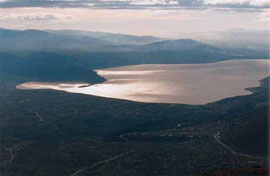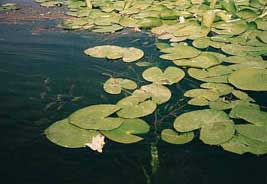|

Lake Vegoritida,
Pella

Agras Lake, Edessa
|
The Wetlands of the Prefecture of Pella, situated in the heart of Macedonia: a)
Vegoritida
lake. b) The wetland Agra-Nisiou-Vryton.
Information: Prefectural Administration of Pella, Government House (Dioikitirio Pellas), GR 582 00 Edessa, Tel. 03810-22838, Fax 03810-25875.
Information about organized tours by boats, bird watching at AGRA wetland, trekking, etc.:
Tourist Information Office of Edessa, Tel. 03810-20300, www.edessacity.gr.
The Wetlands of Koukounaries - Skiathos Isl.: The Koukounaries Wetlands, of Skiathos
are of the greatest interest and value both from an ecological and an' aesthetic point of view.
The beach of Koukounaries is enchanting and many have described it as the most beautiful
in the Mediterranean. Visitors who love nature will find here one of the only two forests in
Greece of Pinus Pinea (the Umbrella Pine) with self-regenerating evergreen broad needles.
In an area of some 12 hectares the visitor will find, as well as Pinus Pinea, a great variety of
plants and shrubs, such as Arbutus Unedo, Erica Arborea, Pistacia Lentiscus, which often
grows to a height of 2-5 metres, as well as mosses, View Tathyroides, Linaria Pelisseriana,
Dorignium Graecum and sand-loving vegetation. In Koukounaries we also find one of the
rarest plants in Greece, the Panctatium Maritimwn.
The beach is about one kilometre in length and 20-100 metres wide. The sand is a golden
colour because it contains smocovite, and for this reason is known as the Golden Beach. Just
behind the forest is the Strophylia lagoon connected by a narrow channel to the sea. It is
home to many species of aquatic birds and also amphibious animals. In winter all kinds of
migratory birds gather there. The Koukounaries Wetlands attract both summer and winter
visitors, and has been made an all year round protected area by the Municipality of Skiathos.
It is a place of the highest ecological importance as well as of rare beauty. It is also organized
so as to provide the visitor with every amenity, but without harming the environment.
Information: Development Enterprise of the Municipality of Skiathos
GR- 370 02 Skiathos, Tel. 04270-23702, 23718, 22022, 22240, Fax 04270-23841, Internet:
www.n-skiathos.gr.
|
|
Kalamas Delta (Epirus): A short distance from Igoumenitsa is one of the most important
wetlands in Greece. The interplay of river and sea creates a great variety of wetland
environments, where more than 170 species of birds live, many of them rare.
The visitor will be captivated by the combinations of nature. The lovely sunsets and
multihued vegetation and the bird watching will be an inexhaustible source of memories.
Lagoons of Alyki and Hortarolimni of Lemnos Isl.: The two wetlands form an integral
ecological system. The area possesses a natural lagoon and littoral flatlands, as well as very
well preserved ecosystems. Because of their geographical location the wetlands serve as a
refuge and breeding ground for rare and protected species of birds.
Due to this the region has been classified among the Special Nature Conservancy Areas of
the NATURA 2000 network, in accordance with Community Directive 92/43.
A typical species that arrives on Lemnos in the autumn and departs in the late spring is the
flamingo. Flamingos range across the whole Mediterranean area, from Iran to the south of
France, and are attracted to the lagoons by the plentiful supply of food and an environment
untroubled by human interference. They live on a species of small shrimp which exists in
abundance in the shallow waters of the lagoons. It has been calculated that each flamingo
eats at least 5 kilos of shrimps per month. Given that the population of flamingos in Greece
is estimated to be about 7-8,000, their presence in the Alyki lagoon in numbers totaling 5,500
in 1996 is clear indication of its importance as a biotope for this species.
It is not only the flamingos, however, that prefer the Alyki lagoon and neighbouring
Hortarolimni as feeding, resting, nesting and breeding places. In these wetlands you can see
swans, herons, ducks, geese, avocets and many other kinds of waterfowl. They are also
important as being one of the very few places in Greece and Europe where even the ruddy
shelduck breeds, many other kinds, like falcons, partridges, bee-eaters, shrikes, etc., are
attracted by the small particular biotopes in the area, which are full of insects, small
mammals and reptiles.
Lake Doirani (Kilkis-Macedonia): A wetland with rare species of birds and plants.
Information: Prefectural Administration of Kilkis, Tel. 03410-37100, 37101. Directorate of
Culture & Tourism, Tel. 03410-37164, Fax 03410-37163.
Thracian Wetlands (Aegiros-Rodope-Thrace): 22 kilometres of protected wetlands. Rare
species of birds like the little egret and the flamingos find refuge here in the lush aquatic
vegetation.
Information: Municipality of Aegiros, Tel. 05310-97878, 97220, e-mail:
egiros@otenet.gr. |